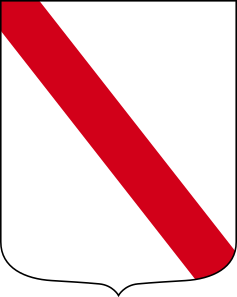
A national flag is a flag that represents and symbolizes a given nation. It is flown by the government of that nation, but can also be flown by its citizens. A national flag is typically designed with specific meanings for its colours and symbols, which may also be used separately from the flag as a symbol of the nation. The design of a national flag is sometimes altered after the occurrence of important historical events. The burning or destruction of a national flag is a greatly symbolic act.
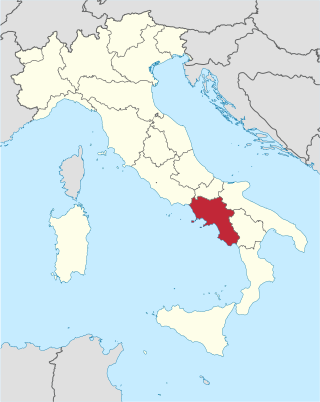
Campania is an administrative region of Italy; most of it is in the south-western portion of the Italian peninsula, but it also includes the small Phlegraean Islands and the island of Capri. The capital of the Campania region is Naples. As of 2018, the region had a population of around 5,820,000 people, making it Italy's third most populous region, and, with an area of 13,590 km2 (5,247 sq mi), its most densely populated region. Based on its GDP, Campania is also the most economically productive region in southern Italy and the 7th most productive in the whole country. Naples' urban area, which is in Campania, is the eighth most populous in the European Union. The region is home to 10 of the 58 UNESCO sites in Italy, including Pompeii and Herculaneum, the Royal Palace of Caserta, the Amalfi Coast and the Historic Centre of Naples. In addition, Campania's Mount Vesuvius is part of the UNESCO World Network of Biosphere Reserves.

Salerno is an ancient city and comune (municipality) in Campania, southwestern Italy, and is the capital of the namesake province, being the second largest city in the region by number of inhabitants, after Naples. It is located on the Gulf of Salerno on the Tyrrhenian Sea. In recent history the city hosted Victor Emmanuel III, the King of Italy, who moved from Rome in 1943 after Italy negotiated a peace with the Allies in World War II, making Salerno the capital of the "Government of the South" and therefore provisional government seat for six months. Some of the Allied landings during Operation Avalanche occurred near Salerno.

Sorrento is a town overlooking the Bay of Naples in Southern Italy. A popular tourist destination, Sorrento is located on the Sorrentine Peninsula at the south-eastern terminus of the Circumvesuviana rail line, within easy access from Naples and Pompei. The town is widely known for its small ceramics, lacework and marquetry (woodwork) shops.
A thalassocracy or thalattocracy, sometimes also maritime empire, is a state with primarily maritime realms, an empire at sea, or a seaborne empire. Traditional thalassocracies seldom dominate interiors, even in their home territories. Examples of this were the Phoenician states of Tyre, Sidon and Carthage; the Italian maritime republics of Venice and Genoa of the Mediterranean; the Chola dynasty of Tamil Nadu in India; the Omani Empire of Arabia; and the Austronesian empires of Srivijaya and Majapahit in Maritime Southeast Asia. Thalassocracies can thus be distinguished from traditional empires, where a state's territories, though possibly linked principally or solely by the sea lanes, generally extend into mainland interiors in a tellurocracy.

The national flag of Italy, often referred to in Italian as il Tricolore, is a tricolour featuring three equally sized vertical pales of green, white and red, national colours of Italy, with the green at the hoist side, as defined by article 12 of the Constitution of the Italian Republic. The Italian law regulates its use and display, protecting its defense and providing for the crime of insulting it; it also prescribes its teaching in Italian schools together with other national symbols of Italy.

Ravello is a town and comune situated above the Amalfi Coast in the province of Salerno, Campania, Southern Italy, with approximately 2,500 inhabitants. Its scenic location makes it a popular tourist destination, and earned it a listing as a UNESCO World Heritage Site in 1997.
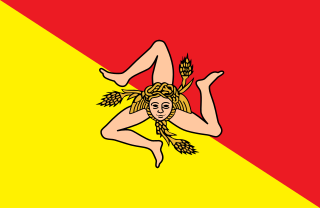
The flag of Sicily shows a triskeles symbol, and at its center a Gorgoneion and a pair of wings and three wheat ears. In the original flag, the wheat ears did not exist and the colors were reversed. The original flag was created in 1282 during the rebellion of the Sicilian Vespers.

The Duchy of Amalfi or the Republic of Amalfi was a de facto independent state centered on the Southern Italian city of Amalfi during the 10th and 11th centuries. The city and its territory were originally part of the larger ducatus Neapolitanus, governed by a patrician, but it extracted itself from Byzantine vassalage and first elected a duke in 958.

The Republic of Pisa was an independent state existing from the 11th to the 15th century and centered on the Tuscan city of Pisa. It rose to become an economic powerhouse, a commercial center whose merchants dominated Mediterranean and Italian trade for a century, before being surpassed and superseded by the Republic of Genoa.
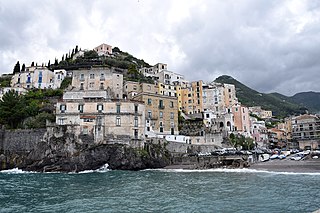
Minori is a comune in the province of Salerno, in the Campania region of south-western Italy. As a part of the Amalfi Coast, it was declared a UNESCO World Heritage Site in 1997.
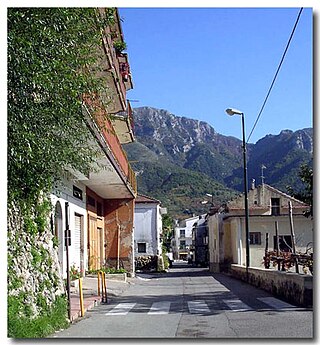
Tramonti is a town and comune in the province of Salerno in the Campania region of south-western Italy. It is located in the territory of the Amalfi Coast.

The maritime republics, also called merchant republics, were Italian thalassocratic port cities which, starting from the Middle Ages, enjoyed political autonomy and economic prosperity brought about by their maritime activities. The term, coined during the 19th century, generally refers to four Italian cities, whose coats of arms have been shown since 1947 on the flags of the Italian Navy and the Italian Merchant Navy: Amalfi, Genoa, Pisa, and Venice. In addition to the four best known cities, Ancona, Gaeta, Noli, and, in Dalmatia, Ragusa, are also considered maritime republics; in certain historical periods, they had no secondary importance compared to some of the better known cities.

The Pisan Cross is the symbol of the northern Italian city of Pisa and its predecessor state, the sovereign maritime Republic of Pisa. was the coat of arms of the people of Pisa, granted to them by Pope Benedict VIII to fight Saracens in Sardinia in 1017.

The flag of Liguria is one of the official symbols of the region of Liguria, Italy. The current flag was adopted on 7 July 1997.

The flag of Marche is one of the official symbols of the region of Marche, Italy. Like many Italian regional flags, it was adopted on 4 November 1995 for Armed Forces Day of Italy. In absence of a law on the subject, the regional emblem that had been adopted on 15 March 1980 was simply inserted on a white background.

The flag of Campania is the regional flag of Campania in Italy. The flag is the coat of arms of Campania superimposed on the a field of azure. The coat of arms of Campania has as its coat of arms the one that the Maritime Republic of Amalfi gave itself at its dawn. This coat of arms consists of a red band on a white field.

The flag of Lombardy is one of the official symbols of the region of Lombardy, Italy. The current flag was officially adopted on 4 February 2019, although it has been used de facto since 12 June 1975.

The flag of Tuscany is the official flag of the region of Tuscany, Italy. The flag depicts a silver Pegasus rampant on a white field between two horizontal red bands. The flag first appeared as a gonfalon on 20 May 1975 along with accompanying text Regione Toscana above the Pegasus. It was officially adopted as the flag of Tuscany on 3 February 1995.

Ancient Campania originally indicated the territory of the ancient city of Capua in the Roman period, and later also the plains of the various neighbouring municipalities. It was a very large territory when compared with the other Italic cities of the Roman and pre-Roman period.
